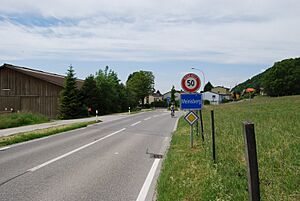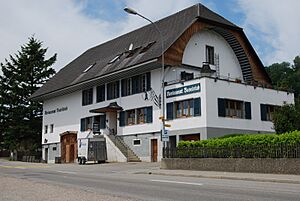Meinisberg facts for kids
Quick facts for kids
Meinisberg
|
||
|---|---|---|

Meinisberg municipal administration building
|
||
|
||
| Country | Switzerland | |
| Canton | Bern | |
| District | Biel/Bienne | |
| Area | ||
| • Total | 4.4 km2 (1.7 sq mi) | |
| Elevation | 445 m (1,460 ft) | |
| Population
(Dec 2020 )
|
||
| • Total | 1,326 | |
| • Density | 301/km2 (781/sq mi) | |
| Postal code |
2554
|
|
| Surrounded by | Büren an der Aare, Lengnau, Pieterlen, Safnern | |
Meinisberg is a small town, also called a municipality, located in the Biel/Bienne area of the canton of Bern in Switzerland. It's a peaceful place with a rich history and beautiful natural surroundings.
Contents
A Look at Meinisberg's Past
Meinisberg was first mentioned in official records way back in 1332. It was known as Meynesberg then. For a while, it also had a French name, Montmenil, but that name isn't used anymore.
People have lived in this area for a very long time! Tools and items from the Mesolithic (Middle Stone Age) and Neolithic (New Stone Age) periods have been found here. These discoveries show that people were living and working in Meinisberg thousands of years ago. Later, artifacts from the La Tène culture (an ancient Celtic culture) and the Roman times were also discovered. Even a wooden castle from the High Middle Ages was found nearby.
For many years, from the Late Middle Ages, Meinisberg was part of the area ruled by Pieterlen. This region was under the control of the Prince-Bishop of Basel, who was a powerful religious and political leader. In 1816, Meinisberg became part of the Bern canton. Then, in 1833, it became its own independent community.
A big change happened between 1865 and 1875 when the Nidau-Büren canal was built. This made the Aare River flow past Meinisberg, which was important for trade and travel. The town grew because it was close to the Naturschutzgebiets Häftli, a beautiful nature park, and it was easy to get to the larger city of Biel/Bienne.
Where is Meinisberg?
Meinisberg is located at the bottom of the Büttenberg mountain. It sits along the old path of the Aare river. The municipality covers an area of about 4.4 square kilometers (about 1.7 square miles).
A large part of Meinisberg's land, about 54.5%, is used for farming. This means there are many fields for crops and pastures for animals. Forests cover about 25.1% of the area, providing green spaces and homes for wildlife. The rest of the land is used for buildings, roads, and some rivers or lakes.
Meinisberg used to be part of the Büren district. But on January 1, 2010, it became part of the new Biel/Bienne administrative district.
Meinisberg's Coat of Arms
A coat of arms is like a special symbol or emblem for a town or family. Meinisberg's coat of arms shows a green vine with blue grapes. This vine grows from three green hills on a silver background. It's a unique design that represents the community.
Who Lives in Meinisberg?
Meinisberg has a population of about 1,200 people. Over the past ten years, the number of people living here has grown by about 6.7%. Most of this growth has been from people moving into the town.
Most people in Meinisberg speak German as their main language, about 90%. Some people also speak French or Albanian.
The population is pretty evenly split between males and females. About 23% of the people are children and teenagers (under 19 years old). Adults (20-64 years old) make up about 57.3% of the population, and seniors (over 64 years old) are about 19.7%.
Many people who live in Meinisberg were born there or in the same canton (region) of Switzerland. About 10.7% of the residents were born outside of Switzerland.
Working in Meinisberg
In 2011, Meinisberg had a very low unemployment rate, which means most people who wanted to work had jobs.
The town has different types of jobs:
- Primary sector: This includes jobs related to nature, like farming. About 26 people work in this area, mostly in agriculture.
- Secondary sector: These jobs involve making things, like in factories or construction. About 71 people work in this sector, with many in construction.
- Tertiary sector: This is the largest group, with about 121 people working in services. This includes jobs in shops, restaurants, transportation, and education.
Many people who live in Meinisberg travel to other towns for work. About 60.2% of working residents use a private car to get to their jobs, while 14% use public transportation.
Religious Life
According to a census from 2000, most people in Meinisberg belong to the Swiss Reformed Church, which is a Protestant church, about 69%. About 11.5% of the population are Roman Catholic. There are also smaller groups of people who belong to other Christian churches, or are Islamic or Buddhist. Some people do not belong to any church.
Learning in Meinisberg
Education is important in Meinisberg. About 45.3% of the adults have finished high school, and 12% have gone on to college or a special technical school.
The school system in the Canton of Bern works like this:
- One year of optional Kindergarten.
- Six years of Primary school.
- Three years of required lower Secondary school. After this, students can choose to continue their education or start an apprenticeship (learning a trade on the job).
During the 2009-2010 school year, 117 students attended classes in Meinisberg. There were 29 kindergarten students and 88 primary school students. Some students in Meinisberg's schools have a different first language than the language used in the classroom, which shows the diversity of the community.
While some students from Meinisberg go to school in other towns, a few students from other municipalities also come to Meinisberg for their education.
See also
 In Spanish: Meinisberg para niños
In Spanish: Meinisberg para niños







